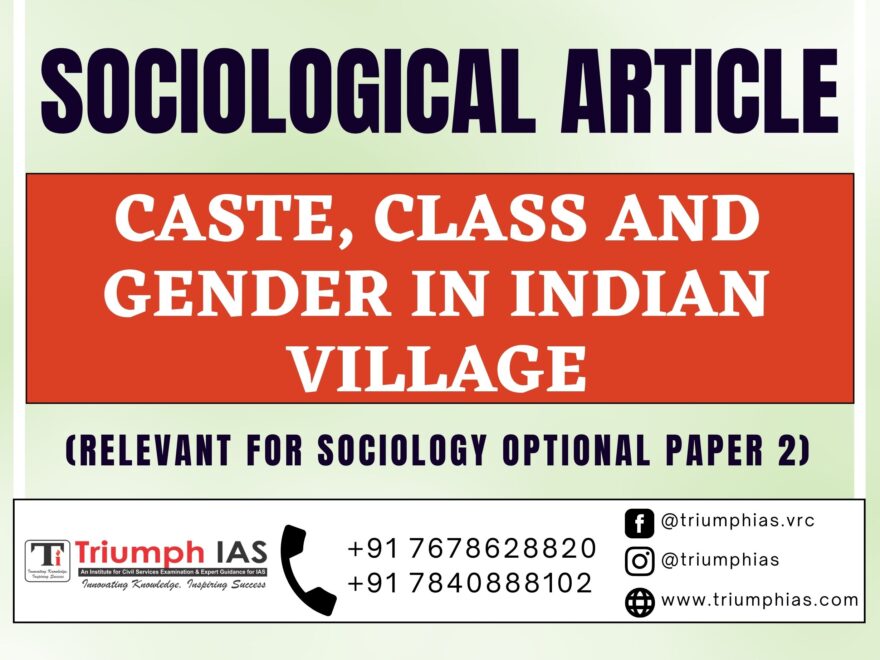
CASTE, CLASS AND GENDER IN INDIAN VILLAGE
Relevant for Sociology Optional Paper 2

Caste
- The Indian society has long been characterized by caste and hierarchy, which were first theorized in modern sociological language during the colonial period. Caste was seen as the most important and distinctive feature of Indian society, and hierarchy was its accompanying ideology. Caste guided social relationships in the Indian village as a concrete structure, while hierarchy governed their beliefs and values.
- In a caste society, people lived in a hierarchical world, where everything, from food to manners, was ranked in an order of hierarchy. Anthropologists commonly referred to the Varna system of hierarchy, which divided Hindu society into five major categories. Each category had its own legitimate occupations defined by tradition, with several sub-groups arranged in a hierarchical order. Despite a general framework, there were significant variations in different regions, where socially autonomous castes were practically independent in their socio-religious spheres of life.
- Caste divisions determined all social relations, with entry into a social status determined by heredity rather than individual achievement or personal quality. However, Srinivas argued that mobility was possible in caste, and the way caste operated at the local level was different from the Varna scheme. Mutual rank was uncertain, and higher ritual status could not be achieved solely through rituals and lifestyle imitation but also required negotiation at the local power structure.
- Dube identified six factors that contributed to status differentiation in the village community of Shamirpet, including religion and caste, landownership, wealth, position in government service and village organization, age, and distinctive personality traits. Lower-caste panchayats worked as unions to secure their employment and strengthen their bargaining power vis-a-vis the land-owning dominant castes. However, most scholars viewed the caste system as working within the framework of the jajmani system, binding together different castes living in the village or a cluster of villages in enduring and pervasive relationships.
- Despite being a closed system, caste still underwent changes as people attempted to claim higher ritual status through sanskritisation, which required negotiation with the local power structure. Meanwhile, secular factors also played a role, as lower-caste panchayats worked to secure their employment and strengthen their bargaining power vis-a-vis the dominant castes. Overall, caste and hierarchy remained defining features of Indian society, but they were not static and underwent changes over time.
Land and Class
- The social scientists studying India during the 1950s and 1960s predominantly adopted a caste-based framework. Sociology in India tended to focus on “small communities” and therefore, agriculture and the social relations of production on land were also included in village monographs, although economists were primarily concerned with class and land issues.
- For most sociologists, economic life was considered an aspect of the caste and occupational structure of the village, with land relations reflecting the same patterns of hierarchy as those present in the caste system. According to Srinivas, there was an overlap between the hierarchies of caste and land, as richer landowners generally belonged to high castes such as Brahmins and Lingayats, while the landless laborers were mostly from lower castes, such as Harijans.
- While some researchers argued that land ownership was the most important factor in determining social hierarchy in the village, village studies still focused primarily on caste, family, kinship, and religion. There was a lack of exploration into the details of agrarian social structures in different regions of the country. Oscar Lewis, for instance, compared a Brahmin-dominated village with a Jat-dominated village and argued that it was land ownership, rather than caste membership per se, that gave individuals status and power.
Gender Differences
- In the majority of village studies, the examination of gender relations focused on the household and the participation of women in work. These studies highlighted the division of labor within the family and the overall dominance that men enjoyed in the public sphere. Women, especially among the upper castes, were restricted to the confines of their homes.
- Srinivas argued that “the social world of women was synonymous with the household and kinship group, while men inhabited a more heterogeneous world.” In comparison to men in the Central Indian village studied by Mayer, “women had fewer opportunities to meet people from other parts of the village. The village well provided a meeting place for all women of non-Harijan castes, and the opportunity for gossip. However, there was a limit to the time that busy women could stand and talk while they drew their water, and afterwards, they must return home, where the occasions for talking to people outside their own household were limited to meeting with other women of the street.”
- Dube’s study of the Telangana village revealed that women were isolated from public activities. “It was considered a mark of respectability for women to walk with their eyes downcast.”
Village community in today’s India
The present day villages all over India are not similar they are different in physical structure, ecological setting, their functional importance, internal composition, economy and power structure.
Even then some common features can be derived;
- According to Deepankar Gupta, the majority of villagers nowadays engage in non-agricultural activities. In Haryana villages, Jodhka noted that landowning peasant castes and families have diversified their occupations, managing rural land, running businesses in the city, and working as doctors, engineers, or professors. While not all sociologists agree with this perspective, it is clear that the economic situation in villages has become more diverse due to (1) developmental programs, (2) the Green Revolution, and (3) the role of markets in the age of liberalization.
- Louis Dumont stated that a village is a political community with power and a desire to manage its own affairs. However, according to Yogendra Singh, in the 1950s and 1960s, power structures in villages were mostly determined by land ownership and caste hierarchy. This has changed due to democratic institutions, lower caste assertion, and increasing competitiveness among caste groups.
- Jan Bremen argues that, despite increased competition and conflict, a sense of fictive kinship still exists among villagers. In terms of cultural dimensions, village religious festivals have come under dispute. Some argue that there are now more than one function in the village, while others, such as Balai Gopal, argue that backward castes have taken the initiative in organizing them, indicating a change in the cultural metrics of village communities.
- Caste and gender were important factors that governed the division of labor in villages. Men exercised control over the domestic economy, making annual grain payments to artisans and servicing castes. The dominant “male view” considered women incapable of understanding what went on outside the domestic wall.
- Men had near-complete control over women’s sexuality, and monogamous families, popular among most groups in India, reinforced men’s sense of private property in their wives’ genital organs. Women lacked any right to land or an exclusive right to their husband’s sexual prowess. Polygyny and concubinage were both evidence of their lack of such rights.
- Patriarchy and male dominance were considered legitimate norms, and husbands were expected to be authoritative figures whose will should always dominate the domestic scene. As heads of the household, husbands were expected to demand respect and obedience from their wives and children. Wives were expected to regard their husbands as their “masters” and “serve them faithfully”.
CONCLUSIVE ANALYSIS
- The studies conducted by social anthropologists on Indian villages during the 1950s and 1960s were a significant turning point in the history of Indian social sciences. Although the primary focus of these studies was on the social and ritual life of the villagers, they offered insightful glimpses into the political and economic life of rural Indian society during the first two decades of independent India.
- These studies were crucial in countering the dominant colonial stereotype of the Indian village, which portrayed it as an isolated community. The in-depth ethnographic accounts of village life, based on extensive fieldwork, convincingly demonstrated that Indian villages were well integrated into the broader economy and society of the region even before the introduction of new agrarian legislation by the colonial rulers. Furthermore, these studies revealed significant regional variations in the social organization of village life in different parts of the country.
- These studies also presented an alternative to the idealized model of the Varna system as theorized in Hindu scriptures. While caste was an important institution in the Indian village, empirical studies showed that it was not a completely closed and rigidly defined system. Caste statuses were not exclusively determined by one’s position in the ritual hierarchy, and there were many grey and contestable areas within the system. Concepts like sanskritisation, dominant caste, segmental structures, and harmonic and disharmonic systems emerged from these studies.
- However, these studies were limited by the method of participant observation, which was their main strength. The need for acceptability in the village community often led to a conservative orientation in their accounts of village life. The anthropologists’ focus on the dominant groups in the village also limited their access to the worldviews of subordinate groups and made them suspect among the lower castes.
- Moreover, the received theoretical perspectives and professional traditions within the disciplines of sociology and social anthropology during the time of village studies also influenced the scholars’ accounts. Sociologists tended to focus on structures rather than changes, which made them overlook conflict and the possible sources of social transformation.
- In conclusion, while the studies of Indian villages conducted by social anthropologists during the 1950s and 1960s were a significant milestone in the history of Indian social sciences, they were constrained by methodological and theoretical limitations that shaped the image they produced of the Indian village.

